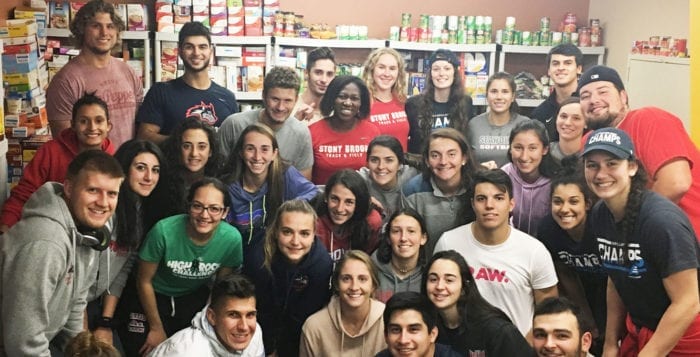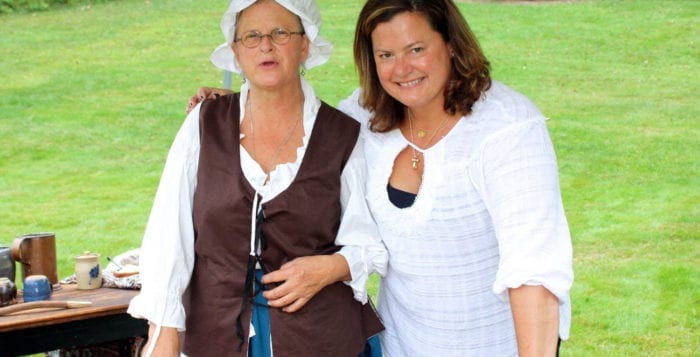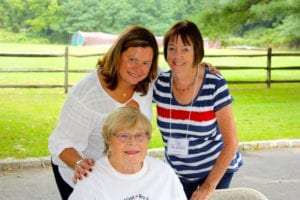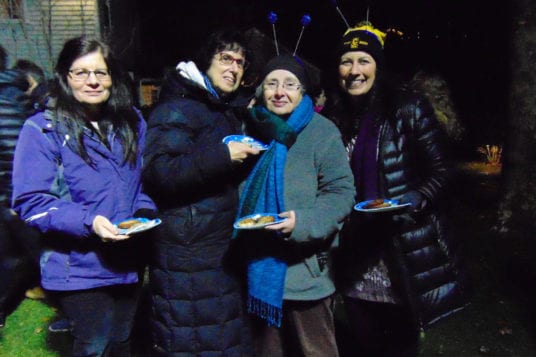A battle might be on the horizon over a proposed cellphone tower.
Before the Jan. 9 public board meeting in the Village of Old Field, residents living slightly outside the community’s borders received a letter simply signed “Concerned Neighbors.” A number of residents were alarmed to hear the village board was proposing the construction of a cellphone tower at a public park known by many as Kaltenborn Commons located at the intersection of Old Field Road and Quaker Path.
The letter writers asked residents of Old Field and surrounding streets to attend the monthly meeting to voice their concerns about health, economic and aesthetic issues. The agenda for the meeting included a presentation by Tanya Negron, founder of Elite Towers, a Long Island-based company that develops wireless telecommunications tower sites and is working on the Old Field project, to answer any questions.
A few dozen Old Field and Setauket residents crammed into the small Keeper’s Cottage that serves as the village’s meeting hall. Negron said the proposed tower, which is similar to the one on the bluff in Belle Terre, will have a 50-by-50-foot footprint. A stealth concealment pole, the slim structure will have cellphone carrier antennae inside, and the only antennae that would be outside are for emergency agencies, such as the fire department, if requested.

Negron said the area around it will be landscaped based on the village’s recommendations and no trees will be removed. The pole will be centralized within the property and set back from the road 132 feet on the west, 130 feet on the east and 160 feet to the south.
Many in attendance raised concerns and asked questions of the board members, with Mayor Michael Levine multiple times reminding participants to speak one at a time.
Former board member John Von Lintig said when he sat on the board for six years, the suggestion of installing a cellphone tower came up frequently. The conclusion was always that there was no suitable place to put it in the village without negatively affecting those around it.
“You put it right in the gateway of the village, and it is unconfirmed but with definitely possible health effects, it has possible economic effects on the homes immediately surrounding on resale, and it has aesthetic impact on people coming into the village seeing this thing,” Von Lintig said.
While a few in the room believed there are no health consequences in association with cellphone tower poles, one Setauket couple, who live across from the park, said they worry about potential health risks.
“We have three kids that are in that park daily,” Charles Catania said. “You can’t promise me or tell me there are no health consequences in connection with this pole.”
Oleg Gang, who works at Brookhaven National Laboratory, said he lives in close proximity to the proposed location. He said the savings in property taxes due to the revenue generated by the pole was negligible, and even with WiFi and an extender, it’s possible to improve an individual’s cellphone service at home.
Gang said board members need to research studies concerning the increase of various cancers and other disorders when living a certain distance from a tower, even if the conclusions are not definitive or there are debates.
“The bottom line is it’s not clear, but because it’s not clear, and there are so many technical solutions, and there is no benefit really from the tax point of view because it’s negligible, it’s really irresponsible to put it in the backyard of the people who will be suffering potentially five or 10 years getting cancer,” Gang said.
“We have three kids that are in that park daily. You can’t promise me or tell me there are no health consequences in connection with this pole.”
— Charles Catania
According to the website of the American Cancer Society, there is currently very little evidence to support the idea of cellphone towers increasing the risk of cancers or other health problems.
Many also said the tower will be aesthetically unappealing not only to nearby residents but to those considering buying a home in Old Field.
One resident who lives across from the park and considers the land historic said she found the board a bit smug toward those who didn’t live in the village.
“You are basically desecrating historic land by erecting this horrendous looking thing,” she said. “When we are in our yards, we are going to be laying in our pools or sitting in our lounge chairs looking at this freaking pole that is 130 feet tall. So all you’re saying, first of all comes across a little demeaning to us, and it’s not right at all. Secondly, it does affect our property values.”
She added that she spoke to a real estate agent who said home values can potentially drop 20 percent when such a pole is installed.
To address concerns regarding health issues and real estate prices dropping, Levine asked anyone who knows of experts in the fields to invite them to talk at future board meetings.
One resident in favor of the pole said it will generate tax revenue for the village and make the community more attractive to younger people who don’t use landlines.
“As I look around here, the average age of the person in this room is over 50,” he said. “Let me tell you something; your kids and my kids don’t use landlines, OK? They want cell coverage, and we don’t have decent cell coverage.”
Village lawyer Anthony Guardino said installing the pole would result in $40,000 capital at the outset and another $15,000 capital contribution for each canister that goes in the tower in village revenue. The village would also receive 40 percent of the rent stream from the first carrier, 45 percent from the second and 50 percent from any others.
Levine said if the village decides not to install a pole there is still a chance that Stony Brook University will do so on its Sunwood Estate property as the university has filed a request for proposals to install a cellphone tower, and the estate is one of the suggested locations. If this occurs, the village would not generate any revenue from the SBU pole.
Options were discussed at the meeting including installing the cellphone tower near the Old Field lighthouse. Levine said the location had been considered but the U.S. Coast Guard, which supervises the lighthouse, must approve it. While the village reached out to the Coast Guard, it did not receive a definitive answer.
Another subject of contention was the lack of notification for those who live right outside of Old Field who feel they will be affected. Others said even though they are residents, they were unaware of discussions about a cellphone tower. Levine and Village Clerk Adrienne Kessel reminded residents to sign up for email notifications, and they said the village posts meeting information on its website available to both residents and nonresidents. The mayor also said the village is not legally required to notify nonresidents but they are always welcome to attend the meetings.
Levine stressed that a lease agreement has not been signed yet, and the board will schedule one or two more meetings to hear from Old Field residents and its neighbors. The next public board meeting will be held Feb. 13 at 7 p.m. For more information visit www.oldfieldny.org.




























